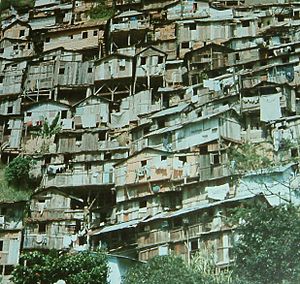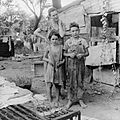Shanty town facts for kids

Shanty towns are areas where people live in homes built from simple, often recycled materials. You'll find them on the edges of many large cities, especially in developing countries. These homes are usually made from things like plywood, corrugated metal, plastic sheets, or even cardboard. They are often put together quickly, just enough to keep out the rain or protect from the hot summer sun.
Living in shanty towns can be tough because there's often no clean water, proper sanitation, or toilets. This can make people, especially children, more likely to get sick from illnesses like hepatitis and cholera.
Contents
What Are Shanty Towns Like?
Many shanty towns are built on land without a permit or official permission. This means they often don't have proper roads, street names, electricity, or telephone lines. Some homes might have a few services, but they can be poorly maintained and dangerous, sometimes causing health or fire hazards. In some very large cities, shanty towns can grow huge, with millions of people living in them, like the famous Favelas in Brazil.
Where Are Shanty Towns Built?
Many shanty town settlements are built near rivers. This can be risky because residents might suffer from floods when the river overflows. They can also be exposed to industrial toxins or pollution in the water. Some shanty towns are even built close to rubbish dumps, which can be unhealthy.
Challenges for Residents
People living in shanty towns often face many difficulties. They might have poor health because of the living conditions and lack of clean water. Access to education can be limited, and there might be higher levels of crime. Sadly, people in shanty towns often have a shorter life expectancy compared to those in more developed areas.
Earning a Living in Shanty Towns
Even with these challenges, many shanty towns have a busy informal economy. This means people find ways to earn money outside of official jobs. They might sort garbage for recycling, make pottery, or create textiles and leather goods. This helps residents earn an income and support their families.
Images for kids
-
Picture of a Petare town created because of the rural flight to Caracas.
-
Shanty towns sometimes have an active informal economy, such as garbage sorting, pottery making, textiles, and leather works. This allows the poor to earn an income. The above shanty town image is from Ezbet Al Nakhl, in Cairo, Egypt, where garbage is sorted manually. Residential area is visible at the top of the image.
-
Shanty towns may be large or small settlements. Above a shanty town in Hong Kong.
-
Khayelitsha Township in Cape Town, South Africa
-
Dharavi shanty town in Mumbai
-
An impoverished American family living in a shanty during the Great Depression. Photographed by Dorothea Lange in 1936
-
Shanty town along the Martin Pena Canal in Puerto Rico (1970s).
-
A shanty town in Manila, Philippines.
See also
 In Spanish: Asentamiento irregular para niños
In Spanish: Asentamiento irregular para niños









